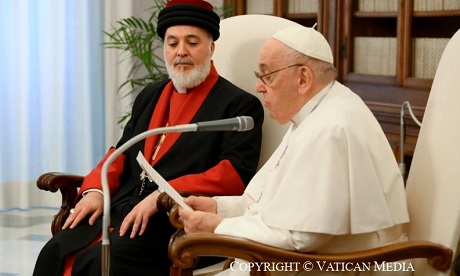A common Easter date between Christians of the East and West is one of the Pope’s particular desires.
He explained his views during a meeting with the U.S.-born patriarch of the Assyrian Church of the East last week.
“Let us have the courage to put an end to this division that at times makes us laugh” with the ridiculous possibility that Christians could ask each other, “When does your Christ rise again?” the pope told Catholicos Awa III, the patriarch of the Assyrian Church of the East.
The Catholicos was elected head of the church a year ago. Last week was his first official visit to the Vatican.
The Assyrian Church of the East is not in full communion with any of the Orthodox or Oriental Orthodox churches.
It began a theological dialogue with the Vatican in the mid-1990s.
Awa also mentioned he and many other Christians hope to find a way to celebrate Easter on the same day.
“We are ready to accept any proposal that is made together,” Francis said, quoting St Paul VI.
Francis noted that in 2025, Christians will celebrate the 1,700th anniversary of the Council of Nicaea.
The Gregorian and Julian calendars will align that year, so Christians of the East and West will celebrate Easter on the same day.
Christian leaders should “be courageous and search together” for a solution that will bring a common celebration of Easter every year, Francis said.
Both he and the Catholic Church are willing to follow what St. Paul VI said. “Agree and we will go where you say.”
In the Second Vatican Council’s 1963 Constitution on the Sacred Liturgy, there is a declaration “on revision of the calendar”.
It says Council members “would not object if the feast of Easter were assigned to a particular Sunday of the Gregorian calendar, provided that those whom it may concern, especially the brethren who are not in communion with the Apostolic See, give their assent.”
Since that time, the Vatican’s position consistently has been that if Eastern Christians agree on a way to determine a common date for Easter, the Catholic Church would accept it.
Before the Council of Nicaea, different Christian communities celebrated Easter on different dates.
The Council decided for the unity of the Christian community and its witness, Easter would be celebrated on the first Sunday after the first full moon after the spring equinox.
The Julian calendar, which Christians used in the fourth century, was increasingly out of sync with the actual solar year.
March 21 – generally assumed to be the date of the Northern Hemisphere’s spring equinox – gradually “drifted” away from the actual equinox.
In 1582, Pope Gregory XIII reformed the calendar, dropping 10 days and making the equinox fall on March 21 again.
Most Eastern Christians did not adopt the new calendar. This resulted in a situation where Easter occasionally is on the same day, but Eastern Christians’ celebration can be as much as four weeks later.
Source
Additional reading
News category: World.




